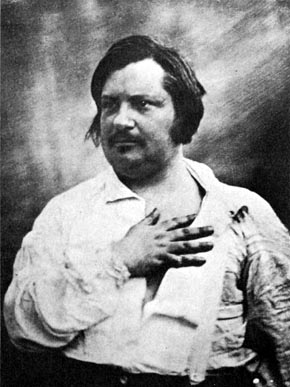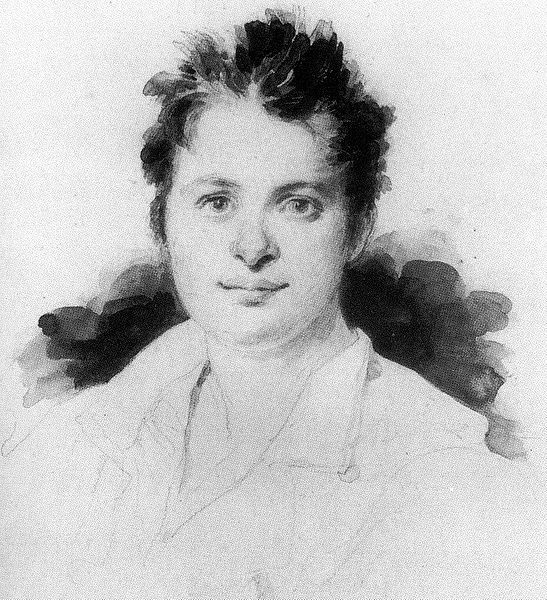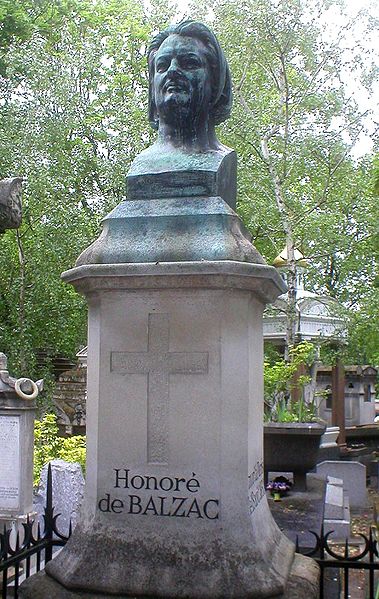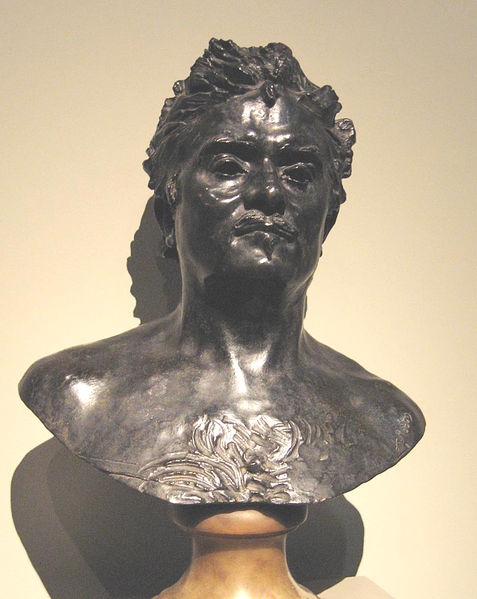<Back to Index>
- Philosopher John Stuart Mill, 1806
- Novelist Honoré de Balzac, 1799
- Prime Minister of the Republic of Poland Władysław Eugeniusz Sikorski, 1881


Honoré de Balzac (20 May 1799 – 18 August 1850) was a French novelist and playwright. His magnum opus was a sequence of almost 100 novels and plays collectively entitled La Comédie humaine, which presents a panorama of French life in the years after the fall of Napoléon Bonaparte in 1815.
Due to his keen observation of detail and unfiltered representation of society, Balzac is regarded as one of the founders of realism in European literature.
He is renowned for his multi-faceted characters; even his lesser
characters are complex, morally ambiguous and fully human. Inanimate
objects are imbued with character as well; the city of Paris, a
backdrop for much of his writing, takes on many human qualities. His
writing influenced many famous authors, including the novelists Marcel Proust, Émile Zola, Charles Dickens, Fedor Dostoyevski, Gustave Flaubert, Marie Corelli, Henry James, Jack Kerouac, and Italo Calvino as well as important philosophers such as Friedrich Engels. Many of Balzac's works have been made into films, and they continue to inspire other writers. An
enthusiastic reader and independent thinker as a child, Balzac had
trouble adapting to the teaching style of his grammar school. His
willful nature caused trouble throughout his life, and frustrated his
ambitions to succeed in the world of business. When he finished school,
Balzac was apprenticed as a legal clerk, but he turned his back on law
after wearying of its inhumanity and banal routine. Before and during
his career as a writer, he attempted to be a publisher, printer,
businessman, critic, and politician. He failed in all of these efforts. La Comédie Humaine reflects his real-life difficulties, and includes scenes from his own experience. Balzac
suffered from health problems throughout his life, possibly due to his
intense writing schedule. His relationship with his family was often
strained by financial and personal drama, and he lost more than one
friend over critical reviews. In 1850, he married Ewelina Hańska, his longtime love; he died five months later. Honoré
Balzac was born into a family which had struggled to achieve
respectability. His father, born Bernard-François Balssa, was
one of eleven children from a poor family in Tarn, a region in the south of France. In 1760 the elder Balzac set off for Paris with only a Louis in his pocket, determined to improve his social standing; by 1776 he had become Secretary to the King's Council and a Freemason.
(He had also changed his name to that of an ancient noble family, and
added – without any official cause – the aristocratic-sounding de.) After the Reign of Terror (1793–94), he was sent to Tours to coordinate supplies for the Army. Balzac's mother, born Anne-Charlotte-Laure Sallambier, came from a family of haberdashers in
Paris. Her family's wealth was a considerable factor in the match: she
was eighteen at the time of the wedding, and Bernard-François
fifty. Honoré (so named after Saint Honoré of Amiens,
who is commemorated on 16 May, four days before Balzac's birthday) was
actually the second child born to the Balzacs; exactly one year
previous, Louis-Daniel had been born, but he lived for only a month.
Afterwards, a third child was born, named Simone de Hudsone. Honoré's sisters Laure and Laurence were born in 1800 and 1802, and his brother Henry-François in 1807. Immediately after his birth, Honoré was sent to a wet-nurse; the following year he was joined by his sister Laure and they spent four years away from home. (Although Genevan philosopher Jean-Jacques Rousseau's influential book Émile convinced
many mothers of the time to nurse their own children, sending babies to
wet-nurses was still common among the middle and upper classes.) When
the Balzac children returned home, they were kept at a frigid distance
by their parents, which affected the author-to-be significantly. His
1835 novel Le Lys dans la Vallée features a cruel governess named Miss Caroline, modeled after his own care-giver. At the age of eight Balzac was sent to the Oratorian grammar school at Vendôme,
where he studied for seven years. His father, seeking to instil the
same hardscrabble work ethic which had gained him the esteem of
society, intentionally sent very little spending money to the boy. This
made him the object of ridicule among his much wealthier schoolmates. Balzac had difficulty adapting to the rote style of
learning at the school. As a result, he was frequently sent to the
"alcove," a punishment cell reserved for disobedient students. (The
janitor at the school, when asked later if he remembered Honoré,
replied: "Remember M. Balzac? I should think I do! I had the honour of
escorting him to the dungeon more than a hundred times!") Still,
his time alone gave the boy ample freedom to read every book which came
his way. Balzac worked these scenes from his boyhood – as he did many
aspects of his life and the lives of those around him – into La Comédie Humaine. His time at Vendôme is reflected in Louis Lambert,
his 1832 novel about a young boy studying at an Oratorian grammar
school at Vendôme. The narrator says : "He devoured books of
every kind, feeding indiscriminately on religious works, history and
literature, philosophy and physics. He had told me that he found
indescribable delight in reading dictionaries for lack of other books." But
though his mind was receiving nourishment, the same could not be said
for Balzac's body. He often fell ill, finally causing the headmaster to contact his family with news of a "sort of a coma". When he returned home, his grandmother said: "Voilà donc comme le collège nous renvoie les jolis que nous lui envoyons!" ("Look how the academy returns the pretty ones we send them!") Balzac
himself attributed his condition to "intellectual congestion", but his
extended confinement in the "alcove" was surely a factor. (Meanwhile,
his father had been writing a treatise on "the means of preventing
thefts and murders, and of restoring the men who commit them to a
useful role in society", in which he heaped disdain on prison as a form
of crime prevention.) In
1814 the Balzac family moved to Paris, and Honoré was sent to
private tutors and schools for the next two and a half years. This was
an unhappy time in his life, during which he attempted suicide on a bridge over the Loire River. In 1816 Balzac entered the Sorbonne, where he studied under three famous professors. François Guizot, who later became prime minister, was Professor of Modern History. Abel-François Villemain, a recent arrival from the Collège Charlemagne, delivered lectures on French and classical literature to packed audiences. And – most influential of all – Victor Cousin's courses on philosophy encouraged his students to think independently. Once
his studies were completed, Balzac was persuaded by his father to
follow him into the law; for three years he trained and worked at the
office of Victor Passez, a friend of the family. It was during this
time that he began to understand the vagaries of human nature. In his
1840 novel Le Notaire,
Balzac wrote that a young person in the legal profession sees "the oily
wheels of every fortune, the hideous wrangling of heirs over corpses
not yet cold, the human heart grappling with the Penal Code." In
1819 Passez offered to make Balzac his successor, but his apprentice
had had enough of the law. He despaired of being "a clerk, a machine, a
riding-school hack, eating and drinking and sleeping at fixed hours. I
should be like everyone else. And that's what they call living, that
life at the grindstone, doing the same thing over and over again…. I am
hungry and nothing is offered to appease my appetite." He announced his intention to be a writer. The
loss of this opportunity caused serious discord in the Balzac
household, although Honoré was not turned away entirely.
Instead, in April 1819, he was allowed to live in the French capital –
as English critic George Saintsbury describes
it – "in a garret furnished in the most Spartan fashion, with a
starvation allowance and an old woman to look after him", while the
rest of the family moved to a house twenty miles [32 km] outside
Paris. Balzac's first project was a libretto for a comic opera called Le Corsaire, based on Lord Byron's The Corsair. Realizing he would have trouble finding a composer, however, he turned to other pursuits. In 1820, he completed the five-act verse tragedy Cromwell. Although it pales in comparison to later works, some critics consider it a quality text. When he finished, Balzac went to Villeparisis and read the entire work to his family; they were unimpressed. He followed this effort by starting (but never finishing) three novels: Sténie, Falthurne, and Corsino. In
1821 Balzac met the enterprising Auguste Lepoitevin, who convinced the
author to write short stories, which Lepoitevin would then sell to
publishers. Balzac then quickly turned to longer works, and by 1826 he
had written nine novels, all published under pseudonyms and often
produced in collaboration with other writers. For example, the scandalous novel Vicaire des Ardennes (1822)
– banned for its depiction of nearly-incestuous relations and, more
egregiously, of a married priest – was attributed to a 'Horace de
Saint-Aubin'. These books were potboiler novels,
designed to sell quickly and titillate audiences. Also during this time, Balzac wrote two pamphlets in support of primogeniture and the Society of Jesus. The latter, regarding the Jesuit order, illustrated his life-long admiration for the Catholic Church. Later, in a preface to La Comédie Humaine,
he wrote: "Christianity, and especially Catholicism, being a complete
repression of man's depraved tendencies, is the greatest element in
Social Order." In
the late 1820s, Balzac also dabbled in several business ventures, a
penchant his sister blamed on the temptation of an unknown neighbor. The
first of these was a publishing enterprise which turned out cheap
one-volume editions of French classics including the works of Molière. This business failed miserably, with many of the books "sold as waste paper". Balzac had better luck publishing the memoirs of Laure Junot, Duchesse d'Abrantès – with whom he also had an affair. Borrowing
money from his family and other sources, he tried again as a printer
and then as a typefounder. But as with the publishing business,
Balzac's inexperience and lack of capital caused his ruin in these
trades. He gave the businesses to a friend (who made them successful)
but carried the debts for many years. In April 1828, he owed his own mother 50,000 francs. This penchant for une bonne spéculation never left Balzac. It resurfaced painfully much later when – as a renowned and busy author – he traveled to Sardinia in the hopes of reprocessing the slag from the Roman mines in that country. Toward the end of his life, he became captivated by the idea of cutting 20,000 acres (81 km2) of oak wood in Ukraine and transporting it for sale in France. In
1832 (after writing several novels), Balzac conceived the idea for an
enormous series of books that would paint a panoramic portrait of "all
aspects of society." When the idea struck, he raced to his sister's
apartment and proclaimed: "I am about to become a genius." Although he originally called it Etudes des Mœurs, it eventually became known as La Comédie Humaine,
and he included in it all of the fiction he published in his lifetime
under his own name. This was to be Balzac's life work and his greatest
achievement. After the collapse of his businesses, Balzac traveled to Brittany and stayed with the de Pommereul family outside Fougères. It was here that he drew inspiration for Les Chouans (1829), a tale of love gone wrong amid the Chouan royalist forces. A
supporter of the crown himself, Balzac paints the
counter-revolutionaries in a sympathetic light – even though they are
the center of the book's most brutal scenes. This was the first book
Balzac released under his own name, and it gave him what one critic
called "passage into the Promised Land". It established him as an author of note (even if the surface owes a debt to Walter Scott) and provided him with a name outside the pseudonyms of his past. Soon afterwards, around the time of his father's death, Balzac wrote El Verdugo –
about a 30-year-old man who kills his father (Balzac was 30 years old
at the time). This was the first work signed "Honoré de Balzac".
Like his father, he added the aristocratic-sounding particle to help
him fit into respected society, but it was a choice based on skill, not
birthright. "The aristocracy and authority of talent are more
substantial than the aristocracy of names and material power", he wrote
in 1830. The
timing of the decision was also significant. Robb frames it this way:
"The disappearance of the father coincides with the adoption of the
nobiliary particle. A symbolic inheritance." Just
as his father had worked his way up from poverty into respectable
society, Balzac considered toil and effort his real mark of nobility. When the July Revolution overthrew Charles X in 1830, Balzac declared himself a Legitimist, supporting Charles' House of Bourbon – but with qualifications. He felt that the new July Monarchy (which
claimed widespread popular support) was disorganized and unprincipled,
in need of a mediator to keep the political peace between the King and
insurgent forces. He called for "a young and vigorous man who belongs
neither to the Directoire nor to the Empire, but who is 1830
incarnate…." He planned to be such a candidate, appealing especially to the higher classes in Chinon.
But after a near-fatal accident in 1832 (he slipped and cracked his
head on the street), Balzac decided not to stand for election. 1831 saw the success of La Peau de Chagrin (The Wild Ass's Skin),
a fable-like tale about a despondent young man named Raphaël de
Valentin who finds an animal skin promising great power and wealth. He
obtains these things, but loses the ability to manage them. In the end,
his health fails and he is consumed by his own confusion. Balzac meant
the story to bear witness to the treacherous turns of life, its
"serpentine motion." In 1833, Balzac released Eugénie Grandet, his first best-selling novel. A
story about a young lady who inherits her father's miserliness, it also
became the most critically acclaimed book of his career. The writing is
simple, yet the individuals (especially the bourgeois title character)
are dynamic and complex. Le Père Goriot (Old Father Goriot, 1835) was his next big success, in which Balzac transposes the story of King Lear to
1820s Paris in order to rage at a society bereft of all love save the
love of money. The centrality of a father in this novel matches
Balzac's own position – not only as mentor to his troubled young
secretary, Jules Sandeau, but
also the fact that he had (most likely) fathered a child,
Marie-Caroline, with his otherwise-married lover, Maria Du Fresnay. In 1836, Balzac took the helm of the Chronique de Paris,
a weekly magazine of society and politics. He tried to enforce strict
impartiality in its pages and a reasoned assessment of various
ideologies. The magazine failed, but in July 1840, he founded another publication called the Revue Parisienne. It lasted for only three issues. These dismal business efforts – and his misadventures in Sardinia – provided an appropriate milieu in which to set the two-volume Illusions Perdues (Lost Illusions,
1843). The novel concerns Lucien de Rubempré, a young poet
trying to make a name for himself, who becomes trapped in the morass of
society's darkest contradictions. Lucien's journalism work is informed
by Balzac's own failed ventures in the field. Splendeurs et misères des courtisanes (The Harlot High and Low, 1847) continues Lucien's story. He is trapped by the Abbé Herrera (Vautrin)
in a convoluted and disastrous plan to regain social status. The book
undergoes a massive temporal rift; the first part (of four) covers a
span of six years, while the final two sections focus on just three
days. Le Cousin Pons (1847) and La Cousine Bette (1848) tell the story of Les Parents Pauvres (The Poor Relations).
The conniving and wrangling over wills and inheritances reflects the
expertise gained by the author as a young law clerk. Balzac's health
was deteriorating by this point, making the completion of this pair of
books a significant accomplishment. Many of his novels were initially serialized, like those of Dickens. Their length was not predetermined. Illusions Perdues extends to a thousand pages after starting inauspiciously in a small-town print shop, whereas La Fille aux yeux d'or (Tiger-eyes, 1835) opens with a broad panorama of Paris but becomes a closely plotted novella of only fifty pages.
Balzac's
work habits are legendary – he did not work quickly, but toiled with an
incredible focus and dedication. His preferred method was to eat a
light meal at five or six in the afternoon, then sleep until midnight.
He then rose and wrote for many hours, fueled by innumerable cups of
black coffee. He would often work for fifteen hours or more at a
stretch; he claimed to have once worked for 48 hours with only three
hours of rest in the middle. He
revised obsessively, covering printer's proofs with changes and
additions to be reset. Balzac sometimes repeated this process during
the publication of a book, causing significant expense for both himself
and the publisher. As
a result, the finished product was frequently quite different from the
original book. While some of his books never reached a finished state,
some of those – such as Les employés (The Government Clerks, 1841) – are nonetheless noted by critics. Although Balzac was "by turns a hermit and a vagrant", he managed to stay connected to the social world which nourished his writing. He was friends with Théophile Gautier and Pierre-Marie-Charles de Bernard du Grail de la Villette, and he knew Victor Hugo. Nevertheless, he did not spend as much time in salons and
clubs as did many of his characters. He would, however, often spend long periods staying at Château de Saché, near Tours,
the home of his friend Jean de Margonne, his mother's lover and father
to her youngest child. Many of Balzac's tormented characters were
conceived in the small second-floor bedroom. Today the Château is
a museum dedicated to the author's life.
In February 1832, Balzac received a letter from Odessa – lacking a return address and signed only by "L'Étrangère" ("The Foreigner") – expressing sadness at the cynicism and atheism in La Peau de Chagrin and its negative portrayal of women. He responded by purchasing a classified advertisement in the Gazette de France,
hoping that his secret critic would find it. Thus began a fifteen-year
correspondence between Balzac and "the object of [his] sweetest dreams": Ewelina Hańska. She was wed to a man twenty years older than herself: Wacław Hański, a wealthy Polish landowner living in Kiev; it was a marriage of convenience to
preserve her family's fortune. In Balzac, Ewelina found a kindred
spirit for her emotional and social desires, with the added benefit of
feeling a connection to the glamorous capital of France. Their
correspondence reveals an intriguing balance of passion, propriety and
patience. When
Wacław Hański died in 1841, his widow and her admirer finally had the
chance to pursue their affections. Competing with the Hungarian composer Franz Liszt, Balzac visited her in St. Petersburg in 1843 and impressed himself on her heart. After a series of economic setbacks, health problems, and prohibitions from the Tsar, the couple was finally able to wed. On
14 March 1850, with Balzac's health in serious decline, they drove from
her estate in Wierzchownia (village of Verkhivnia) to a church in Berdyczów (city
of Berdychiv, today in Ukraine) and were married. The ten-hour journey
to and from the ceremony took a toll on both husband and wife: her feet
were too swollen to walk, and he endured severe heart trouble. Although he married late in life, Balzac had already written two treatises on marriage: Physiologie du Mariage and Scènes de la Vie Conjugale.
These works suffered from a lack of first-hand knowledge. In
late April the newly married couple set off for Paris. His health
deteriorated on the way, and Ewelina wrote to her daughter about Balzac
being "in a state of extreme weakness" and "sweating profusely". They arrived in the French capital on 20 May, his fifty-first birthday. Five
months after his wedding, on 18 August, Balzac died. His mother was the
only one with him when he expired; Mme. Hańska had gone to bed. He had been visited that day by Victor Hugo, who later served as pallbearer and eulogist at Balzac's funeral. He is buried at the Cimetière du Père Lachaise in
Paris. "Today", said Hugo at the ceremony, "we have a people in black
because of the death of the man of talent; a nation in mourning for a
man of genius." The funeral was attended by "almost every writer in Paris", including Frédérick Lemaître, Gustave Courbet, Dumas père and Dumas fils. Later, Balzac became the subject of a monumental statue by the French sculptor Auguste Rodin, which stands near the intersection of Boulevard Raspail and Boulevard Montparnasse. Rodin featured Balzac in several of his smaller sculptures as well.

